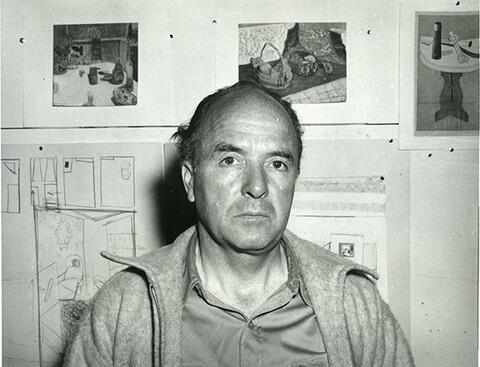
Zona do título e menção de responsabilidade
Título próprio
Emma Lake Artists' Workshop - Jack Shadbolt
Designação geral do material
- Material gráfico
Título paralelo
Outra informação do título
Título e menções de responsabilidade
Notas ao título
Nível de descrição
Item
Entidade detentora
Código de referência
Zona de edição
Menção de edição
Menção de responsabilidade da edição
Zona de detalhes específicos de materiais
Menção da escala (cartográfica)
Menção da projecção (cartográfica)
Menção das coordenadas (cartográfico)
Menção da escala (arquitectura)
Autoridade emissora e denominação (filatélica)
Zona de datas de criação
Data(s)
-
1955 (Produção)
Zona de descrição física
Descrição física
1 photograph : b&w ; 20 x 25 cm
Zona dos editores das publicações
Título próprio do recurso continuado
Títulos paralelos das publicações do editor
Outra informação do título das publicações do editor
Menção de responsabilidade relativa ao editor do recurso contínuo
Numeração das publicações do editor
Nota sobre as publicações do editor
Zona da descrição do arquivo
Nome do produtor
História custodial
Âmbito e conteúdo
Head and shoulders image of Jack Shadbolt, first guest artist at the inaugural Emma Lake Artists Workshop.
Bio/Historical Note: Kenneth Lochhead and Arthur McKay, professors at the University of Saskatchewan, Regina Campus (now called the University of Regina since 1974) initiated the Emma Lake Artists' Workshops in 1955.
Bio/Historical Note: Jack Leonard Shadbolt was born 4 February 1909 at Shoeburyness, England. In 1912 the family moved to British Columbia, eventually settling in Victoria. In the late 1920s, after studying at the Victoria College and Normal School, he met Emily Carr. "I was dumbstruck with admiration," Shadbolt later said. Carr's renderings of Northwest Coast Indian symbols eventually led to Shadbolt's own exploration of aboriginal images. But at this time, his paintings focused on what he called the "dark, satanic mills" of industrial landscape. Shadbolt studied at the Art Students' League in New York City (1948) and in London (1937) and Paris (1938). After teaching art to children in BC between 1929 and 1937, he joined the Vancouver School of Art. During 1944-1945 Shadbolt was assigned to the official Canadian Army war artists program in London. One of his jobs was sorting through army photographs of concentration camps. Looking at still lifes of emaciated bodies, then roaming around bombed-out London, had a profound psychological impact on the artist. After the war Shadbolt returned to the school, where he was head of painting and drawing until 1966. He was an influential teacher and adviser across Canada and the US, having conducted workshops (he was the first artist to do so at the Emma Lake Artists' Workshops in 1955) and juried exhibitions throughout North America. Some 70 solo exhibitions of Jack Shadbolt's work were mounted and his many major international exhibitions included the Venice Biennale XXVIII and 4 major retrospective exhibitions at the Vancouver Art Gallery, the BC Museum of Anthropology, the National Gallery of Canada and the Glenbow Museum. An extraordinarily prolific artist, Shadbolt worked in large series (or suites) which derived from his personal experiences of nature and Native art in BC, his many travels in Europe and his recognition of calligraphy and op-art; in paint slashes and in incisive lines, in butterflies and totem poles, in insect life and ritual brides, in poetry and architecture. As well as painting many murals (Edmonton International Airport, the National Arts Centre and the former CBC building), he did stage, ballet and costume designs and theatre posters. Shadbolt authored In Search of Form (1968), Mind's I (1973) and Act of Art (1981). Until his death, he continued to have an enormous output, such as the 3-dimensional plywood relief created for the MacMillan Bloedel building in Vancouver (1987). In 1988 he and his wife, Doris (nee Meisel), started VIVA, the Vancouver Institute for Visual Arts, which offered monetary awards to local visual artists - two yearly $10,000 awards and one $50,000 every fifth year. He also supported Artists for Kids Trust, generating $500,000 to assist Vancouver-area students. Among many honours was the appointment as Officer of the Order of Canada in 1972. At the time of his death, Shadbolt was planning a new show for February 1998. Jack Shadbolt died 22 November 1998 in Burnaby, British Columbia, at age 89.

